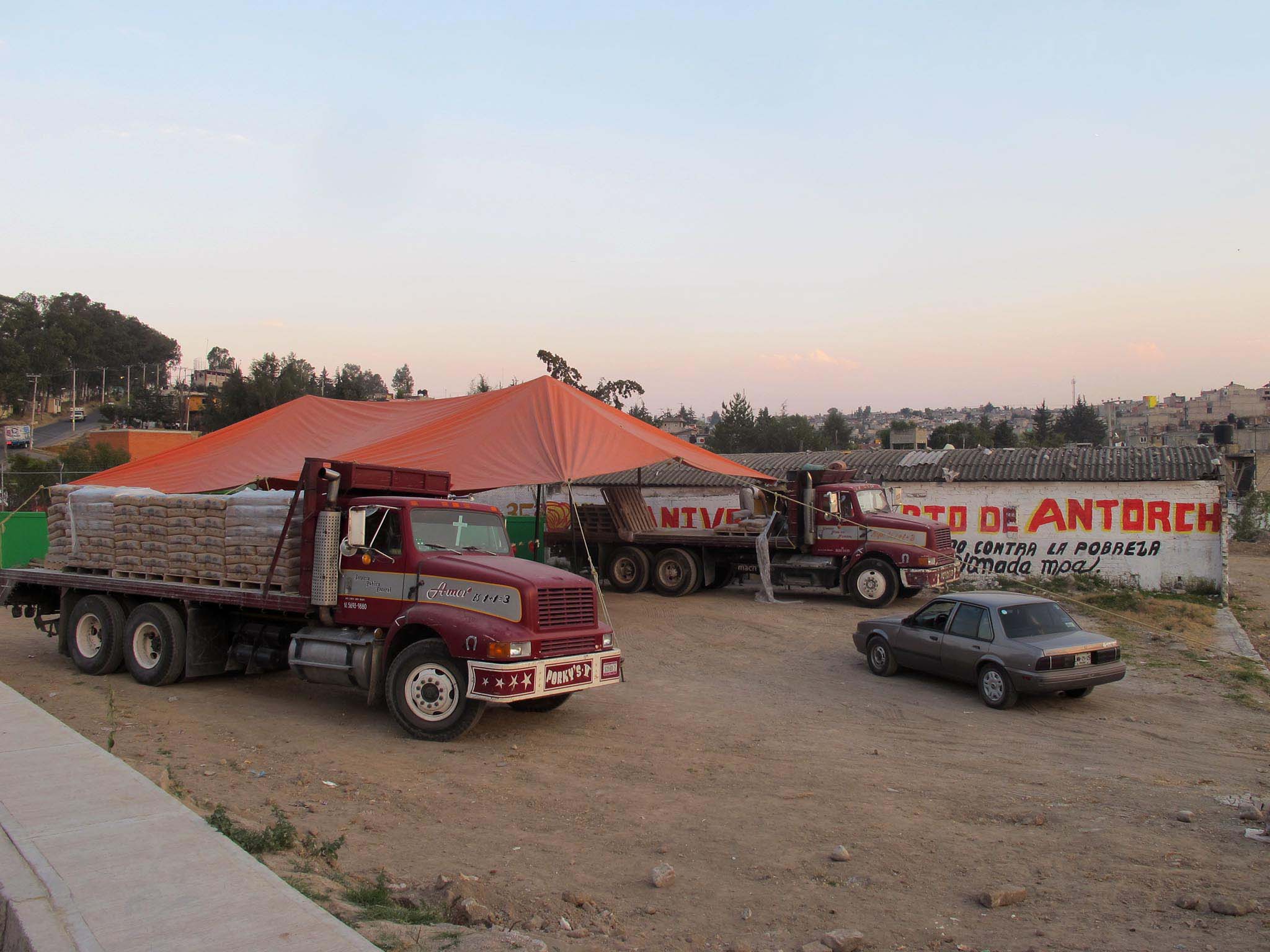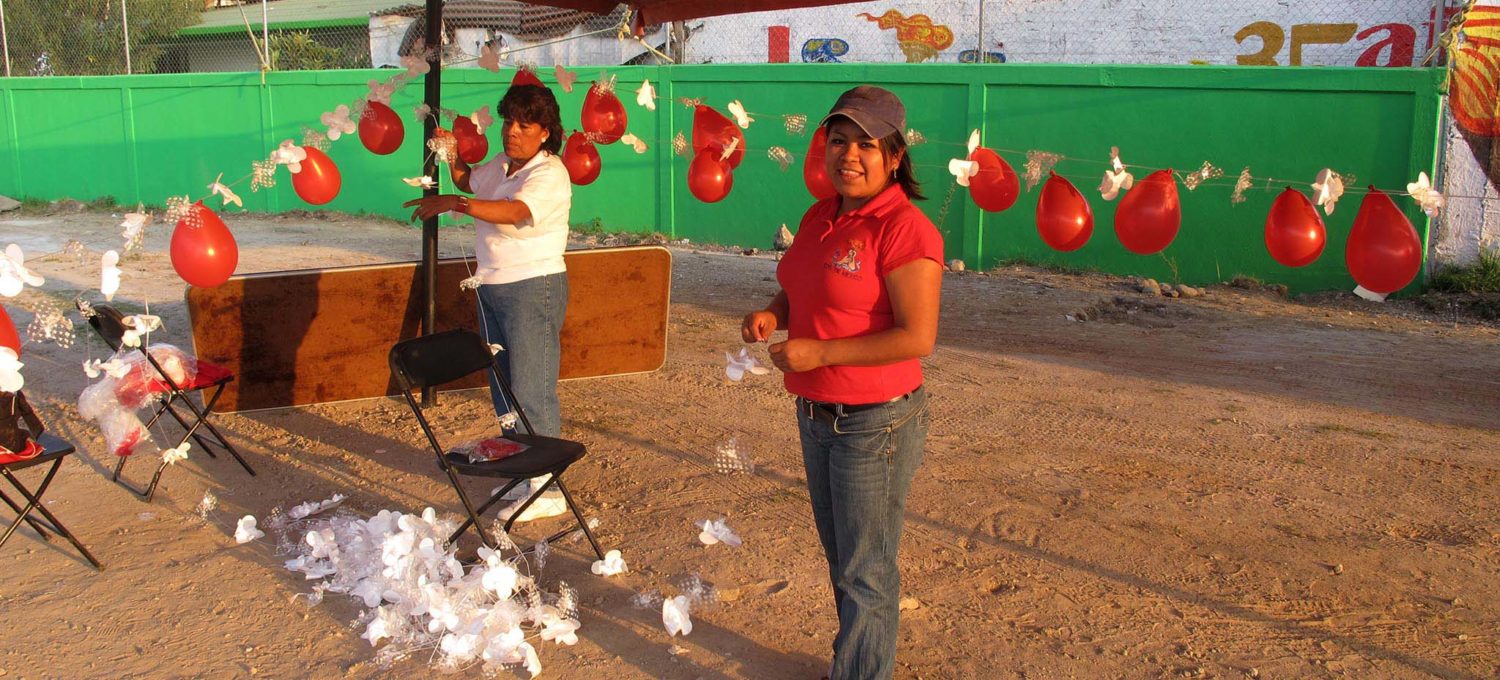I rounded the long fingers of the reservoir, the Presa de Guadalupe, its deep waters flooding the hillsides. The lake was ringed with villas along a wide road of smooth, well maintained asphalt. Fences and walls separated the villas from the road. Trees covered the hillside, and recreational boats lay on the banks. A genteel and quiet air hung over the waters edge. A large curtain dam with sluices held back the stream flooding the valley. I walked on amid the flowering ornamental trees and wide lawns.
Finally I passed over a low slope and everything changed. The lake and trees disappeared, rows of grey self-built housing stretched in front of me. In a parking lot in front of some offices a red tent had been set up. Next to it stood trucks loaded with bags of cement. A chubby young woman wearing a baseball cap over her black hair, with a red polo shirt and jeans, stood behind a long table. She was preparing the distribution of the bags of cement. The logo of a hand carrying a flaming torch was stitched onto her shirt. She was a militant of the Antorcha Campesina.
I walked up to her and told her I was on an expedition around the edge of the city and that I had seen many colonias of antorchistas, high up in the hills of Iztapaluca, in the former lakebed of Chalco. I had even been stopped from entering one such colonia in Chimalhuacán by Antorcha security guards. The chubby young woman looked at me with both pride and suspicion, explaining a little pedantically what she continually explained to the settlers, yet at the same time suspicious of a bourgeois foreigner.
The movement had been founded in the 70s. She told me that militants of the Antorcha Campesina left their families behind. Couples were separated and sent to different parts of the country and the children were brought up in boarding schools in Tecomatlán, the village on Puebla where the Antorcha Campesina has its main base. Every year they even hold there own Olympic games there, the Espartacadas. She said they were Maoists trying to consolidate enough political power in Mexico for a workers revolution.

She had been participating in study groups in the university. Some of her companions had been children of antorchistas and discussed the organization with her. They channeled her towards the movement and she left the university to study in a school for teachers in Chimalhuacán. She said they were sent to urban neighborhoods to help intermediate with authorities for public services. Though many of the settlers did not share the ideology of the movement, the movement would solve their necessities. The movement still did not have the force of a true workers party and the bourgeoisie would not give up power easily. The true party consisted of the leadership cadres to which she belonged. They were the soldiers of the people who would bring socialism and communism to the Mexican people.
In the end, the goal of Antorcha Campesina is to change the social class in power. The young organizer said that poverty, organized crime and insufficient education all fomented the need for organized struggle. As long as the people holding political power did not know what it was like to live without water or drainage and were only interested in pursuing the interests of its own class, there would be no change in Mexico.
She said they did not seek their own good but that of the public. She had been a councilwoman in Ecatepec, as part of her political duties, and been working for 7 years now as an organizer. She had no family as that would absorb too much time and distract from her work.
She said that the goal of the organization was to form its own political party when it had sufficient members. But at the moment they only had 1.5 million members, not enough to be an electoral force. She hoped that in 5 years they would have grown enough to become a political party, which she said would require around 6 million members. I imagined bankers and executives being thrown off steel and glass corporate towers to the cheers of the masses below.
The government did not care about the true education of the people and here they were taught poetry and dance. And she as leader would have to lead in the events.
She said the antorchista movement was strongest in the east of the megalopolis though in the Nicolás Romero they had Ampliación Lomas and 5 more colonias – Aquiles Córdova, Wenceslao Victoria, Crescencio Sánchez, Elsa Córdova Morán and Clara Córdova – named after Antorcha activists who had been killed. The history of the movement could be read on the city’s maps through the names of its dead.
